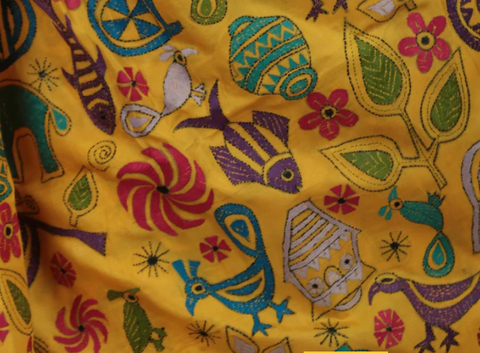Indian culture is very vivid, so are the embroidery designs of India. Each region and each sect has its own embroidery style, technique and pattern over the centuries.
The popular Kantha Embroidery is predominantly the traditional folk art practiced by the rural women of Bengal.
Kantha means ‘Patched Cloth’. It is the traditional embroidery of West Bengal, done with folk motifs and running stitch. The special significance of Kantha is to make quilts by joining the layers of old sarees. Kantha embroidery was considered a tool of self-expression by the women of Bengal.

(Kantha Embroidery)
There are two types of Kantha embroideries. In the first type, the old, discarded cotton saris or dhotis are stacked up, quilted and embroidered. And in the other type the discarded cotton bed spreads are quilted and the pictorial embroidery is done with Tussar Silk threads.
Other popular embroideries are the chikan work, the zari work and Kashida.
Chikankari found its origin in Lucknow, Uttar Pradesh. It is a delicate and artfully done hand embroidery .This fine, subtle form of embroidery is usually done over a very fine textured cloth like muslin and cotton. The color of the thread with which embroidery is usually done is the same as the cloth itself. Like green thread is used on light green cloth while white thread may be used on white cloth.

(Chikankari)
Kashida
Kashida, also known as Kasida, is an embroidery done on cotton clothes using silk threads. Although it has gained maximum fame and recognition in the land of Jammu and Kashmir, it is quite popular in West Bengal as well. This embroidery is done using thick colored threads and beads to create different patterns. Kashida embroidery is primarily done on caps and scarves worn by the Muslims for prayers.

(Kashida)
Motifs of Bengal
Symbols and motifs are a vital part of Bengali folk art .These motifs are like a medium of self expression for the artisans. They represent various aspects of life and nature. These motifs were originated from several objects of daily life such as creepers, flowers, rivers, birds and animals, fish, pets, sun, moon, stars, planets etc.

Nature related motifs like paisley, palka, twigs, flower is used in taant, jamdani and muslin sarees, whereas religious motifs are used in Balucharis.
The most common symbols and motifs, used to design the folk arts, are
Kalka Motif
Also known as "Persian pickle" or "Welsh pear" the kalka or paisley motif originated in Persia and Kashmir. It looks like a decorated pearl drop. It can be compared with a stylized leaf, mango or flame.
Lotus Motif
The lotus motif is the most common motif found in kanthas. This motif is associated with Hindu iconography and thus is also very popular in the kantha. It is also symbolic of cosmic harmony and essential womanhood.
Swastika Motif
This motif is also known as muchri or golok dhanda. Swasti in Sanskrit means” it is well”. As a motif in Indian art, it dates back to the Indus Valley Civilization. It is a symbol of good fortune, divinity and spirituality.
Khunti-lata Motif
It represents design of creepers composed of conch shell diagrams, wavy and interwoven leaves and creepers. The depiction of a creeper of conch shells is woven on Baluchari Sarees.
Other popular motifs are:
Kalmi-
It represents lotus buds or watercress creepers,
Shankha-lata
This motif represents paddy stalks.
Pakhi
This motif is inspired by birds and it celebrates freedom.
Palki
It represents a palanquin, carrying women or royalty
Ghora
Horse, often from a battle scene
Moyur
Peacock
Nortoki
Female dancer, from a palatial or festive scene
Roth
Chariot

